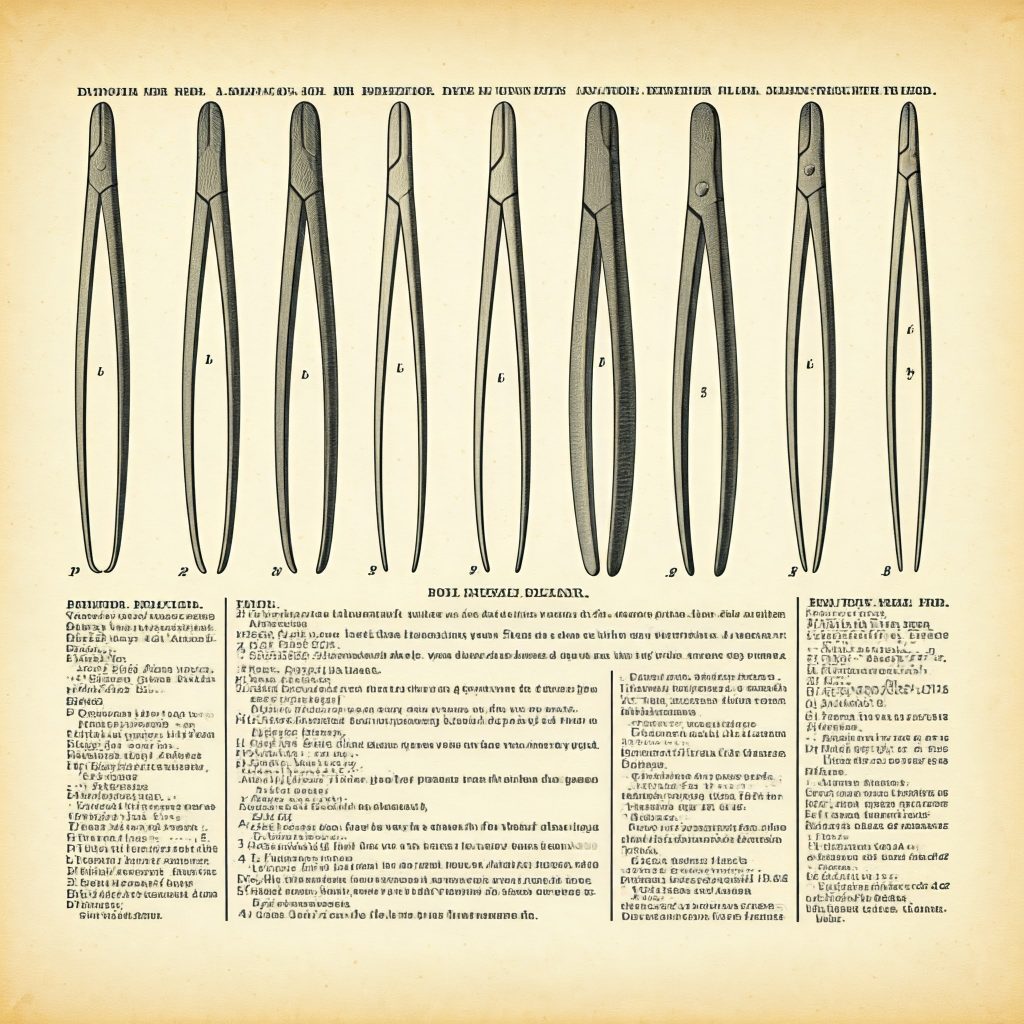
Forceps are versatile and essential tools commonly used in medical, surgical, and dental fields, as well as in other industries requiring precise handling of delicate materials or tissues. This comprehensive guide covers everything you need about forceps, from types, uses, and selection tips to proper care and maintenance. This guide will give you clear insights into the various uses of forceps, whether you are a medical professional, dentist, or just interested in surgical tools.
Table of Contents
| TRANDING: Chimney Rock State Park |
What Are Forceps?
Forceps are handheld instruments designed to grasp, hold, clamp, or manipulate objects that are too small, delicate, or intricate for fingers to manage effectively. Most forceps are made of stainless steel, which is durable, corrosion-resistant, and ideal for sterilization, though some disposable versions are made of plastic. Forceps vary in size, shape, and function, tailored to specific tasks such as clamping tissues during surgery, extracting teeth, or assisting in childbirth.
Key Features of Forceps
- Material: Usually stainless steel for durability, corrosion resistance, and ease of sterilization. Plastic forceps are used in single-use scenarios.
- Mechanism: Resembling scissors, forceps typically have two arms joined by a hinge or pivot, allowing for controlled movement.
- Tip Variety: Forceps tips can be sharp, blunt, serrated, or curved, depending on their purpose.
Types of Forceps
Each type of forceps is intended to perform a specific function in dental, surgical, or medical procedures, and they are classified based on their design and intended use. The various kinds of forceps are broken down as follows:
Surgical Forceps
Used primarily in operating rooms and other medical settings, surgical forceps assist in manipulating tissues, clamping blood vessels, and handling sutures. They are essential for performing intricate operations and controlling bleeding during surgery.
- Thumb Forceps: These are simple, tweezer-like tools used for grasping or holding tissues. They come in various designs for specific tasks.
- Examples: Adson forceps (used in plastic surgery) and tissue forceps (to handle tissues without causing damage).
- Hemostatic Forceps: Designed with a locking mechanism, these forceps clamp blood vessels to control bleeding during surgeries.
- Examples: Kelly forceps, Mosquito forceps.
Obstetric Forceps
Obstetric forceps are specially designed to assist in the delivery of babies during childbirth. They are used when necessary to guide the baby’s head through the birth canal safely and with minimal injury to the mother and child.
- Examples: Simpson forceps, which are designed for use in deliveries where the baby is in the proper position, and Kielland forceps, used in more complex cases such as when the baby’s head is not ideally positioned.
Dental Forceps
Dentists frequently use dental forceps for procedures like tooth extractions. Their robust design provides excellent leverage, enabling practitioners to remove teeth safely and efficiently without damaging surrounding tissues.
- Examples: Cowhorn forceps for lower molar extractions, and Upper molar forceps designed to grip and extract upper teeth.
Tissue Forceps
These are used during surgeries to grip and handle delicate tissues, ensuring minimal trauma. Tissue forceps are crucial in general and specialized fields, including plastic and cardiovascular surgery.
- Examples: DeBakey forceps (commonly used in cardiovascular procedures) and Allis tissue forceps (often used in soft tissue manipulation).
Dressing Forceps
Dressing forceps are used for handling surgical dressings, applying or removing dressings during operations, and grasping delicate tissues during non-surgical procedures.
- Examples: Magill forceps, commonly used to apply bandages or move surgical sponges during operations.
Thumb Forceps
Thumb forceps are versatile, easy-to-use instruments that don’t have a locking mechanism. They are designed to be operated by squeezing them between the thumb and forefinger.
- Examples: Adson thumb forceps (often used in surgery) and Dressing forceps for holding sterile dressings.
Bone-Holding Forceps
Used in orthopedic surgeries, these forceps are designed to grasp and manipulate bones during procedures such as fracture repairs.
- Examples: Lane bone-holding forceps, which offer a firm grip on the bone, facilitating precise positioning and manipulation.

Common Uses of Forceps
Forceps serve various purposes, largely depending on their type and specific design. Here are the most common applications across different fields:
Medical and Surgical Applications
- Manipulating tissues during surgeries.
- Clamping blood vessels to control bleeding.
- Holding or guiding sutures during wound closure.
- Removing foreign objects from wounds or body cavities.
Dental Applications
- Extracting teeth during oral surgeries.
- Handling dental materials, including fillings and prosthetics.
- Manipulating oral tissues during procedures such as periodontal surgeries.
Obstetric Applications
- Assisting with childbirth by gently guiding the baby’s head.
- Reducing shoulder dystocia is a complication where the baby’s shoulders get stuck after the head has emerged.
Laboratory Applications
- Handling delicate specimens, like tissues or chemicals, during scientific research.
- Grasping small objects in various laboratory environments.
Household and Craft Uses
In non-medical settings, forceps or tweezers can be used for tasks such as:
- Grasping small parts during repairs.
- Handling delicate craft materials like beads or model components.
Care and Maintenance of Forceps
Proper care is essential to prolong the life of forceps and maintain their functionality, particularly in sterile environments like hospitals or clinics.
Cleaning
Forceps must be thoroughly cleaned after each use to remove any contaminants like blood, tissue, or debris.
- Manual Cleaning: Use a soft brush and mild detergent to clean the forceps, paying special attention to any grooves or serrations.
- Ultrasonic Cleaning: During deeper cleaning, contaminants that are hidden can be effectively removed with the use of ultrasonic cleaners.
Sterilization
Sterilization is crucial to prevent infections. Most forceps can be sterilized through autoclaving, a method that uses high-pressure steam to disinfect instruments.
- Autoclave: Place the forceps in an autoclave machine, following the manufacturer’s guidelines.
- Chemical Sterilization: Chemical sterilization techniques, such as ethylene oxide (EO) gas, are ideal for sensitive materials or disposable plastic forceps.
Maintenance
- Lubrication: Regularly lubricate the hinge and moving parts to ensure smooth operation.
- Inspection: Frequently inspect for signs of wear, damage, or rust. Damaged forceps should be repaired or replaced to prevent harm during use.
- Storage: Store forceps in a dry, sterile environment to avoid contamination and rust.
How to Choose the Right Forceps
Selecting the appropriate forceps is critical to ensuring successful outcomes in both medical and non-medical tasks. Here are some factors to consider:
Intended Use
- Medical or Surgical Use: Choose based on the specific procedure—hemostats for clamping, thumb forceps for tissue manipulation.
- Dental Use: Ensure the forceps have adequate grip and leverage for tooth extraction or other dental procedures.
- Obstetric Use: Opt for forceps designed to assist safely in childbirth without causing trauma.
Tip Design
- Serrated or Flat Tips: Serrated tips provide a better grip on tissues, while flat tips are ideal for non-traumatic tasks.
- Curved or Straight Tips: Curved tips help access difficult areas, whereas straight tips offer more control.
Material and Durability
- Stainless Steel: Ideal for repeated sterilization and use.
- Disposable Forceps: Made from plastic, intended for single-use to avoid contamination.
Conclusion
Forceps are essential tools in the medical, dental, and surgical industries, as well as in non-medical environments. From handling tissues and clamping blood vessels to assisting in childbirth and extracting teeth, forceps play an important role in precision work. Understanding the different types, their uses, and how to care for them is key to making the most of these invaluable tools.
Proper care and maintenance—cleaning, sterilization, and routine inspections—will ensure the longevity and effectiveness of your forceps. Selecting the correct type for each task, based on the procedure, will help achieve the best outcomes.
FAQs
What are forceps made of?
Forceps are primarily made from high-quality stainless steel due to their strength, durability, and resistance to rust. Some disposable forceps are made from plastic.
How are forceps sterilized?
Most forceps are sterilized using autoclaving, a high-temperature steam method. Other methods like chemical sterilization (using ethylene oxide) are also used for delicate instruments.
What are the main types of surgical forceps?
The main types of surgical forceps include thumb forceps, used for grasping tissues, and hemostatic forceps, used to clamp blood vessels and control bleeding.
Can forceps be reused?
Yes, most forceps, particularly those made of stainless steel, can be reused after proper cleaning and sterilization. However, disposable forceps made of plastic are designed for single use.
What is the difference between tissue forceps and dressing forceps?
Tissue forceps are used during surgical procedures to manipulate tissues without causing significant damage. Dressing forceps, on the other hand, are used for applying or removing dressings and tend to have blunt tips.
What are obstetric forceps used for?
Obstetric forceps are used during childbirth to assist in guiding the baby’s head through the birth canal in difficult deliveries.
How often should forceps be inspected?
Forceps should be inspected regularly, particularly after each use, to check for signs of wear, rust, or damage to the tips or joints.
What is the difference between hemostatic and thumb forceps?
Hemostatic forceps have a locking mechanism and are used to clamp and control blood vessels. Thumb forceps are non-locking and used to grasp or hold tissues or objects during surgery.



